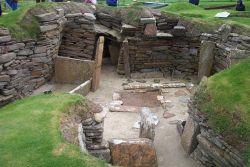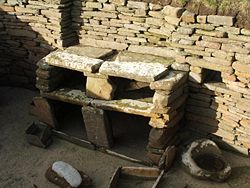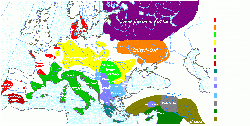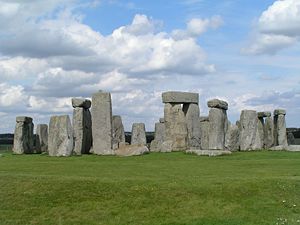Neolithic Age

The Neolithic (or "New" Stone Age) was a period in the development of human technology that is traditionally the last part of the Stone Age. The name was invented by John Lubbock, 1st Baron Avebury (1834-1913) in 1865 as a refinement of the three-age system of stone, bronze, and iron ages. The term is more commonly used in the Old World (Europe), as its application to cultures in the Americas and Oceania is problematic. These cultures are said to have remained neoliytic until the time of the European conquest. It can be roughly dated from about 9000 B.C.E. to 3000 B.C.E.
The Neolithic era follows the terminal Pleistocene Epipalaeolithic and early Holocene Mesolithic periods, beginning with the start of farming and ending when metal tools became widespread in the Copper Age (chalcolithic), Bronze Age or Iron Age, depending on geographical region. The term "Neolithic" thus does not refer to a specific chronological period, but rather to a suite of behavioral and cultural characteristics including the use of both wild and domestic crops and the use of domesticated animals. Some archaeologists have long advocated replacing "Neolithic" with a more descriptive term, such as Early Village Communities, although this term has not gained wide acceptance.
Life as we know it today began to take shape during this period of pre-history (pre-history refers to lack of written records) and while much that has been written about Neolithic culture is speculative, it can be asserted that men and women were becoming more aware of their inter-dependence, of social obligations and of loyalties beyond the immediate family, although evidence here is limited. However, there also appears to have been conflict between groups or tribes. If some theories are correct, this was also a time when the earth and the planet were honored, suggesting a more symbiotic relationship with the land than that of the modern world, where too often the planet is treated as an expendable commodity.
Origins and regional development
In South Asia and the Middle East, cultures identified as Neolithic began appearing soon after the tenth millennium B.C.E. Early development occurred in the Levant (for example, Pre-Pottery Neolithic A and Pre-Pottery Neolithic B) and from there spread eastwards and westwards. Neolithic cultures are also attested in southeastern Anatolia (Turkey) and northern Mesopotamia by approximately 8000 B.C.E.
Neolithic sites and traditions in South Asia include Mehrgarh in the Balochistan region from around 7000 B.C.E., and Lahuradewa from around 6200 B.C.E. in the Ganges valley of the Indian subcontinent. Earlier-dated finds (c. 8000 B.C.E.) of charcoal in some Lahuradewa sites provide indications of slash and burn cultivation techniques present in the area.[1] Further to the west but still within the Ganges valley some studies of deposits at sites such as Sanai Tal Lake have reported cereal pollens dated to around 13000 B.C.E., indicating that this region may have exhibited some of the earliest-known Neolithic traits.[1]
In southeast Europe cultivational societies first appear by around 7000 B.C.E., and in Central Europe by about 5500 B.C.E. Among the earliest cultural complexes of this area are included the Starčevo-Körös (Cris), Linearbandkeramic, and Vinča culture. Through a combination of cultural diffusion and migration of peoples, the Neolithic traditions spread west and northwards to reach northwestern Europe by around 4500 B.C.E.
In Mesoamerica a similar set of events (i.e., crop domestication and sedentary lifestyles) occurred at about 4500 B.C.E., although here the term 'Formative' is used instead of 'Neolithic.'
Early Neolithic farming is limited to a narrow range of crops (both wild and domestic) and the keeping of sheep and goats, but by about 7000 B.C.E. it included the domestication of cows and pigs, the establishment of permanently or semi-permanently inhabited settlements and the use of pottery. Not all of the cultural elements characteristic of the Neolithic (i.e., pottery, permanent villages, and the farming of domestic crops and animals) appear in the same order—e.g. the earliest farming societies in the Near East do not use pottery—and in Britain it remains unclear to what extent plants were domesticated in the earliest Neolithic, or even whether permanently settled communities existed. In other parts of the world, such as Africa, India and Southeast Asia, independent domestication events led to their own regionally-distinctive Neolithic cultures which arose completely independent of those in Europe and Southwest Asia. Early Japanese societies used pottery in the Mesolithic for example.
Social organization

There is little scientific evidence for developed hierarchies in the Neolithic; hierarchies are more closely associated with the later Bronze Age. Families and households were still largely economically independent. Excavations in Central Europe have also revealed that early Neolithic Linear Ceramic cultures were building large arrangements of circular ditches between 4800 B.C.E. and 4600 B.C.E. These structures (and their later Neolithic equivalents such as causewayed enclosures, burial mounds, and henges) required considerable time and labor to construct, which suggests that some influential individuals were able to organize and direct human labor.
There is also good evidence for fortified settlement at Linearbandkeramic sites along the Rhine, as well as evidence for inter-group conflict from Neolithic sites in Britain. Control of labor and inter-group conflict is characteristic of corporate-level or 'tribal' groups, headed by a charismatic individual (e.g., a 'big man,' or proto-chief) such as a lineage group head. These sociopolitical entities later developed into the chiefdoms of the European Early Bronze Age. The Iroquois, Pueblo people, Maya civilization and the Māori are examples of stone-tool-dependent cultures with complex social and political systems.
Religion
Information about the religious beliefs and practices of Neolithic societies are derived from the archeological record, as no there are no written accounts. The elaborate burial mounds, often, like Egyptian pyramids, containing implements, suggest belief in an afterlife. Marija Gimbutas (1921-1994) who taught archeology at the University of California at Los Angeles (UCLA) developed the theory that Neolithic societies in Europe were matriarchal and worshiped the mother-goddess. This fits the archeological record although her theory was considered controversial, since she not only contrasted Neolithic goddess-worship with the more male-dominated religion of the Bronze period but suggested that the former societies were more peaceful and socially inclusive. She considered Neolithic societies to be goddess-centered and matriarchal ("gynocentric," or "gylanic"), and the Bronze Age Indo-European to be patriarchal ("androcratic." According to her, gynocentric / gylanic societies were peaceful; they honored homosexuals; and they espoused economic equality.
She also argued that androcratic people invaded Europe from outside, forcing patriarchal systems onto the conquered. This pattern of early mother or fertility deities yielding to male deities can be seem in several cultures, such as the Indus Valley Civilization and in ancient Nordic society. Some, building on Gimbutas' work, have developed the theory that all human societies originally revered the Mother Goddess, although the eminent anthropologist, James Frazer (1854-1941) also argued that European and Indian religion was originally mother-goddess centered. People at this time may have seen themselves more as 'one-with-the-land' (as do Australian Aborigines and many other aboriginal peoples whose cultures remain 'neolithic') than as separate from and superior to, the natural environment.
The building of quite complex henges, such as Stonehenge near Salisbury, England demonstrates a level of sophisticated knowledge of astronomy, which almost certainly had a religious association possible concerned with the influence of the stars on human life or representative of the human life-cycle. That the construction was hugely significant is suggested by the mere fact that so much energy and effort was invested in transporting the stones and in building and then in maintaining the monument, using only primitive technology. Some, perhaps sympathetic to the mother-goddess theory referred to above, see sexual imagery in the henge.[2] It is generally accepted that the site had a ritual, religious significance. The degree of cooperation that would have been required to construct the Henge may suggest a more highly developed social system than has sometimes been thought characteristic of the period.
Farming
A significant and far-reaching shift in human subsistence and lifestyle was to be brought about in those areas where crop farming and cultivation were first developed, then gradually improved. In these areas, the previous reliance upon a more nomadic hunter-gatherer subsistence technique was at first supplemented, and then increasingly replaced by, a reliance upon the yield produced from cultivated lands. These developments are also believed to have greatly encouraged the growth of settlements, since it may be supposed that the increased need to spend more time and labor in tending crop fields required more localized dwellings. This trend would continue into the Bronze Age, eventually giving rise to towns, and later cities and states whose larger populations could be sustained by the increased productivity from cultivated lands.
The profound differences in human interactions and subsistence methods associated with the early onset of agricultural practices in the Neolithic have been called the Neolithic Revolution, a term first coined by the Australian archaeologist and philologist, Vere Gordon Childe (1892-1957).
One potential benefit of the increasing sophistication and development of farming technology was an ability (if conditions allowed) to produce a crop yield which would be surplus to the immediate needs of the community. When such surpluses were produced, they could be preserved and sequestered for later use during times of seasonal shortfalls, traded with other communities (giving rise to a nascent non-subsistence economy), and in general allowed larger populations to be sustained.
However, it should be noted that early farmers were also adversely affected in times of crop failures, such as may be caused by drought or pestilence. In instances where agriculture had become the predominant way of life the sensitivity to these shortages could be particularly acute, affecting agrarian populations to a sometimes dramatic extent which otherwise may not have been routinely experienced by former hunter-gatherer communities. Nevertheless, despite what must have been periodic setbacks in general agrarian communities proved successful, and their growth and the expansion of territory under cultivation continued.
Another significant change undergone by many of these newly-agrarian communities was one of diet. Whereas hunter-gatherer communities typically have diets with a larger proportion of animal protein, those farmers whose opportunities and motivation for hunting had lessened might have their food intake derived in large part just from the proceeds of their plant cultivation. The relative nutritional benefits and disadvantages of these dietary changes, and their overall impact on early societal development is still the subject of some debate.
The domestication of animals, either as working animal or as a food source (livestock), was another innovation which altered the societal characteristics of those Neolithic communities which adopted it. The animal byproduct of dung could be used as a fertilizer, as fuel or even as a building material. Apart from providing a ready source of protein and dairy-based products, livestock animals could also be used for barter and trade. For those communities where the herding of grazing animals was developed, this often implied a more nomadic existence than is the case for purely crop-based farming, as the animals were herded or migrated to seasonal pastures (a practice known as transhumance).
Technology
Neolithic peoples were skilled farmers, manufacturing a range of tools necessary for the tending, harvesting and processing of crops (such as sickle blades and grinding stones) and food production (e.g. pottery, bone implements). They were also skilled manufacturers of a range of other types of stone tool and ornaments, including projectile points, beads, and statuettes.
Neolithic peoples in the Levant, Anatolia, Syria, northern Mesopotamia and Central Asia were also accomplished builders, utilizing mud-brick to construct houses and villages. At Çatalhöyük, houses were plastered and painted with elaborate scenes of humans and animals. In Europe, long houses built from wattle and daub were constructed. The world's oldest known engineered roadway, the Sweet Track in England, also dates from this time.
Elaborate tombs for the dead were also built. These tombs are particularly numerous in Ireland, where there are many thousand still in existence. Neolithic people in the British Isles built long barrows and chamber tombs for their dead and causewayed camps, henges, flint mines, and cursus monuments. It was also important to figure out ways of preserving food for future months, such as fashioning relatively airtight containers, and using substances like salt as preservatives.
With very small exceptions (a few copper hatchets and spear heads in the Great Lakes region), the peoples of the Americas and the Pacific remained at the Neolithic level of technology up until the time of European contact.
List of Neolithic Settlements
Neolithic settlements include:
- Franchthi Cave in Greece, epipalaeolithic (c. 10000 B.C.E.) settlement, reoccupied between 7500-6000 B.C.E.
- Göbekli Tepe in Turkey, c. 9000 B.C.E.
- Jericho in the Levant, Neolithic from around 8350 B.C.E., arising from the earlier Epipaleolithic Natufian culture
- Nevali Cori in Turkey, c. 8000 B.C.E.
- Çatalhöyük in Turkey, 7500 B.C.E.
- Dispilio in Greece, c. 7500 B.C.E.
- Mehrgarh in Pakistan, 7000 B.C.E.
- Cnossus in Greece, c. 7000 B.C.E.
- Lahuradewa in India, 6200 B.C.E.
- Around 2000 settlements of Trypillian culture, 5400 B.C.E.–2800 B.C.E.
- Knap of Howar and Skara Brae, the Orkney Islands, Scotland, from 3500 B.C.E.
- Brú na Bóinne in Ireland, c. 3500 B.C.E.
Notes
- ↑ 1.0 1.1 National Seminar on the Archaeology of Ganga Plain, December 2004, Lucknow, India.
- ↑ Robin McKie, The vagina monoliths: Stonehenge was ancient sex symbol." The Observer (July 6, 2003). Retrieved April 25, 2007.
ReferencesISBN links support NWE through referral fees
- Bellwood, Peter. First Farmers: The Origins of Agricultural Societies. Oxford: Blackwell Publishers, 2004. ISBN 0631205667
- Lubbock, John. Pre-historic Times, as Illustrated by Ancient Remains, and the Manners and Customs of Modern Savages. London: Williams and Norgate, 1865; Freeport, NY: Books for Libraries Press, 1971. ISBN 0836959914
- Rincon, Paul. "Brutal lives of Stone Age Britons." BBC News (May 11, 2006). Retrieved April 25, 2007.
Credits
New World Encyclopedia writers and editors rewrote and completed the Wikipedia article in accordance with New World Encyclopedia standards. This article abides by terms of the Creative Commons CC-by-sa 3.0 License (CC-by-sa), which may be used and disseminated with proper attribution. Credit is due under the terms of this license that can reference both the New World Encyclopedia contributors and the selfless volunteer contributors of the Wikimedia Foundation. To cite this article click here for a list of acceptable citing formats.The history of earlier contributions by wikipedians is accessible to researchers here:
The history of this article since it was imported to New World Encyclopedia:
Note: Some restrictions may apply to use of individual images which are separately licensed.

